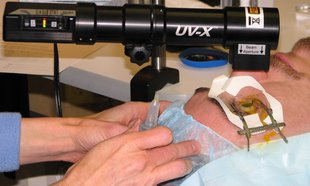Collagen cross-linking is a relatively new treatment for Keratoconus that uses a photosensitizing agent, riboflavin (vitamin B2) & ultraviolet light (UVA, 365nm) exposure. It was developed about ten years ago in Germany by Dr. Theo Seiler. Since then, many countries have approved the CXL procedure for treatment of Keratoconus. CXL is currently in Phase II FDA trials in the US (http://clinicaltrials.gov/ct2/show/NCT00647699).
In extensive experimental studies (including biomechanical stress & strain measurements) researchers have demonstrated a significant increase in corneal rigidity / stiffness after collagen cross-linking using this riboflavin/UVA treatment. The 3 & 5 year results of Dresden clinical study in human eyes has shown the stop of progression of Keratoconus in all treated eyes. (Wollensak G. Crosslinking treatment of progressive keratoconus: New Hope. Current Opinion in Ophthalmology 2006; 17: 356 – 360)
The treatment is performed under topical anesthesia. The skin (epithelium) of the surface of the cornea is partially scratched, followed by application of Riboflavin eye drops for 30 minutes. The eye is then exposed to UVA light for 30 minutes. After the treatment, antibiotic ointment is applied and an eye-pad is worn overnight until the next day when the surface of the eye has healed. Oral analgesics are required for the first 1 -2 days.
Collagen cross-linking treatment is not a cure for keratoconus. Instead, it aims to halt the progression of Keratoconus. This is important to understand. Patients will continue to wear glasses or contact lenses (although a change in the prescription may be required) following the cross-linking treatment. The main objective of CXL is to stop the progression of Keratoconus, thus preventing further deterioration in vision and the need for cornea transplant.
In advanced Keratoconus where the corneal thickness is below 350 microns, CXL may not be performed because of possible damage by the UVA light to other parts of the eye.
skip to main |
skip to sidebar

CXL is a procedure that involves administering riboflavin and UVA in carefully selected parameters that strengthen the front layers of the cornea and avoid damage to the back of the eye.
Click on below link to Watch in HD on large screen
Get an email everytime we post with new update.
CXL Procedure

CXL is a procedure that involves administering riboflavin and UVA in carefully selected parameters that strengthen the front layers of the cornea and avoid damage to the back of the eye.
Keratoconus and CXL links and articles
- Nick Richards blog
- Video Clip about CXL
- Collagen Crosslinking with Riboflavin as a Photosynthesizer
- ClinicalTrial.gov (U.S. CXL study sites)
- One of a Kind Eye Treatment
- Mom Always Said, "Don't Rub Your Eyes"
- National Keratoconus Foundation
- Cornea Research Foundation of America
- The Global Keratoconus Foundation
- Keratoconus on Wikipedia
Blog Archive
About Us
- Janis "Widget" (Marietta, GA) and Connie (Mason, OH)
- We are each moms of incredible sons with Down syndrome who have also both been diagnosed with Keratoconus, one at age 25 and one at age 12. It progressed very rapidly in both our sons, going from mild to advanced in less than a year. CXL seemed like a miracle for us. This blog is to bring awareness of this wonderful treatment of Keratoconus and to encourage the FDA to "fast track" the approval of CXL.

